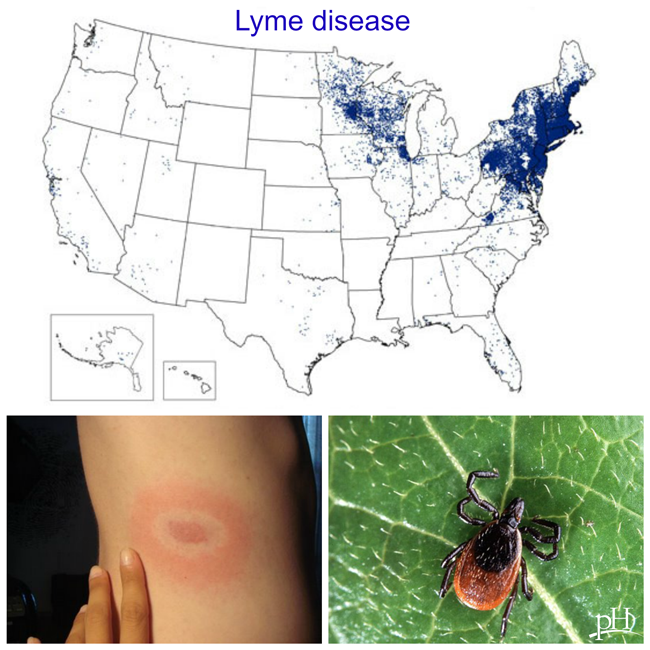Lyme Disease: A Small Tick Bite Can Cause Big Problems
10 years ago | Lyme disease
Map by the CDC: Reported cases of Lyme disease in 2013.
By pH health care professionals
Lyme disease starts with a simple tick-bite, and it’s been on the rise in the United States. This bite introduces bacteria Borrelia burgdorferi into the skin, which can cause a round, gradually expanding rash (Erythema migrans). If left untreated, these bacteria may travel throughout the body, causing a variety of symptoms involving the joints, nervous system and heart.
The CDC reported that 95 percent of confirmed Lyme disease cases were concentrated in the following states: Connecticut, Delaware, Maine, Maryland, Massachusetts, Minnesota, New Hampshire, New Jersey, New York, Pennsylvania, Rhode Island, Vermont, Virginia and Wisconsin. It occurs in many more states, but much less frequently. Review a map of Lyme disease for your personal risk assessment.
How is Lyme disease diagnosed?
Lyme disease is diagnosed by considering the history of a tick bites in your region, looking for a slowly expanding rash around the tick bite area, and serologic testing (detects if your body’s immune system is fighting a microorganism). Currently the CDC recommends a two-step testing process to confirm diagnosis.
What’s the big deal about Lyme disease?
Singer Avril Lavigne recently spoke out about her own struggle with Lyme disease.
"I went from doctor to doctor for about eight months until I found somebody that had the knowledge of Lyme disease and the experience of treating it," she said on Good Morning America. "I actually knew I had it the whole time, probably since the summer, and was just up against a lot of doctors telling me, 'You're crazy.' Some of them were like, 'It doesn't exist.'"
What happens with Lyme is, the tick transmits bacteria in the body, which can migrate and multiply to other areas of the body, affecting various tissues and organs, potentially leading to persistent fatigue, fever, headache, mild stiff neck, muscle and joint aches, and swollen lymph nodes. If undiagnosed and untreated, it can lead to significant disability.
Controversies
There are still disputes about the most accurate Lyme testing, especially when it comes to the issue of chronic Lyme disease.
Once acute Lyme disease is diagnosed, it can be fairly easily treated with antibiotics such as doxycycline or amoxicillin. Nevertheless, some studies and opinions suggest the existence of chronic forms of the disease, although the Infectious Disease Society does not support this notion. In this case, there may be adverse effects from prolonged antibiotic use, so it is generally not advised.
However, further studies are needed to shed more clarity on these issues.
So, how can you be proactive?
- Know areas and regions where tick bites are more common.
- Be watchful to avoid tick bites and use insect repellents.
- If a tick bites you and still tags at the skin, remove it promptly with tweezers.
- Be aware of developing a slowly expanding circular rash and tell your doctor right away.
- When in doubt, see a competent doctor so you can be evaluated and tested. If you are struggling to get a diagnosis, you may want to utilize patient advocacy services.
Enjoy Your Healthy Life!
The pH professional health care team includes recognized experts from a variety of health care and related disciplines, including physicians, attorneys, nutritionists, nurses and certified fitness instructors. This team also includes the members of the pH Medical Advisory Board, which constantly monitors all pH programs, products and services. To learn more about the pH Medical Advisory Board, click here.



